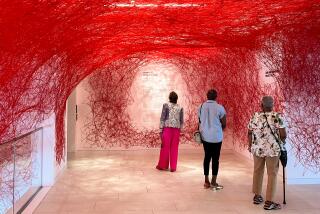Art Museum Sells Photographs at N.Y. Auction
- Share via
The San Diego Museum of Art sold 39 photographs for a total of $268,000 on Wednesday, virtually wiping out the museum’s photographic holdings. The sale included historic works that had been held by the museum since the 1920s, none of which were exhibited in recent years.
The sale at Sotheby’s auction house in New York offered the museum’s entire collection of 66 photographs, including works by Edward Weston, Alfred Stieglitz, Clarence White and Berenice Abbott, as well as some by lesser-known artists.
Selling works from a museum collection at auction is commonplace, particularly at a time when art markets are as volatile as they are today.
Malcolm Warner, San Diego Museum of Art curator of prints and drawings, called the move to sell the museum’s photographic holdings “a bold decision.”
“We decided we don’t need to pursue photographs,” he said Thursday, explaining that the museum will purchase prints and drawings with the proceeds from the sale.
“If we’d sold them locally, we’d have sold them between (Sotheby’s) low and high estimates, and we’d have been robbing ourselves of tens of thousands of dollars,” Warner said. For example, Weston’s “Palm Trunk, Cuernavaca” (1925), which brought $154,000 at Sotheby’s, the highest price of the San Diego works sold, had been estimated to bring in between $30,000 and $50,000 locally, Warner said.
But Arthur Ollman, director of San Diego’s Museum of Photographic Arts, a neighbor in Balboa Park to the larger, more comprehensive museum of world art, said “Palm Trunk, Cuernavaca,” among others, had more than just monetary value for the city of San Diego. It was purchased by the museum in the 1920s from a solo show of Weston’s work at the San Diego Museum of Art, one of the renowned artist’s first museum shows, Ollman said.
Some of the sold photographs had “deep and enduring connections with San Diego,” Ollman said.
Other works sold include works by “California Pictorialist” photographers from the 1920s, Florence Kemmler and Roland Schneider, who are nationally known. Ollman called the artists “among the top salon photographers of their time.”
Another work, Stieglitz’s famous 1907 photogravure, “The Steerage,” also was sold. Twenty-seven works did not reach the museum’s minimum asking price and did not sell at the semiannual New York photographic sale. In general, works that do not sell at auction are held for a later sale, and Warner indicated the unsold works would not be returning to the museum.
Ollman said the photography museum had attempted to buy the entire collection but had not succeeded.
“We tried to negotiate with the San Diego Museum of Art for these pieces, but they preferred to take them to auction,” Ollman said Thursday. He said the photography museum did purchase one work sold by the San Diego Museum of Art at Sotheby’s, but he would not say which one.
Warner said he believes the loss to San Diego of the museum’s photographic collection will not have an impact on the city, as the photos did not have any public following because they had not been shown in years.
“I cannot explain why they haven’t been shown, I haven’t been here long enough,” he said. Warner came to the museum in early 1990 and Steven Brezzo, the museum’s director for the past 12 years, could not be reached for comment.
“It wouldn’t have made much sense as a representation of photography,” Warner said.
Warner said the museum would have been willing to loan the works to the photographic museum but that the museum had never asked to borrow them.
“They only showed any interest in them after they heard we were selling them,” Warner said.
But Ollman said he and his staff at the photography museum were unaware of the collection until he heard of the plans to sell it.
“We never knew they existed,” Ollman said. “There’s probably a lot of other things in their collection that we don’t know exist. It’s not common to go shopping in other museum’s collections. I had no particular need to go looking for things they had in their collection. If they had it in their collection, it’s their responsibility to show it, especially when it’s world-famous material.”
More to Read
The biggest entertainment stories
Get our big stories about Hollywood, film, television, music, arts, culture and more right in your inbox as soon as they publish.
You may occasionally receive promotional content from the Los Angeles Times.










